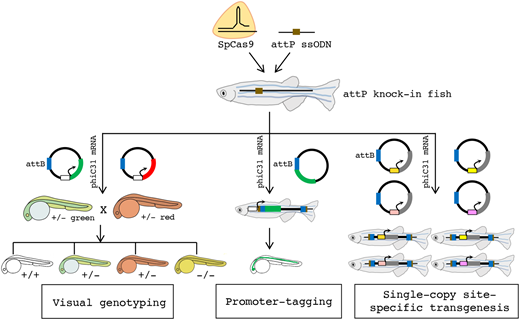Fig. 1 An overview of the TICIT technology for visual genotyping, promoter-tagging, and single-copy, site-specific transgenesis. CRISPR-Cas9 from S. pyogenes (SpCas9) is employed together with a single-stranded oligodeoxynucleotide (ssODN) containing the phiC31 landing site to create attP knock-in fish lines. Next, single-copy site-specific transgene integration is achieved by co-delivering the phiC31 mRNA with any plasmids containing the phiC31 attachment sequence attB. For visual genotyping, two plasmids carrying fluorescent markers driven by a promoter of user's choice (shown as unshaded boxes) are used. This enables Cas9-mediated gene mutations to be identified by fluorescence even before mutant phenotypes manifest. In a heterozygous intercross, wild-type offspring are unmarked, heterozygous offspring are either green or red, and homozygous offspring are both green and red (shown as yellow). For promoter-tagging, a plasmid carrying a promoter-less fluorescent marker adjacent to the attB sequence is used. After phiC31-mediated integration, the promoter activity of the target gene can be tracked by the expression of the fluorescent marker. Further, fish lines carrying attP knock-in at pre-defined loci may enable facile transgenesis devoid of positional and copy number artifacts.
Image
Figure Caption
Acknowledgments
This image is the copyrighted work of the attributed author or publisher, and
ZFIN has permission only to display this image to its users.
Additional permissions should be obtained from the applicable author or publisher of the image.
Full text @ Biol. Open

